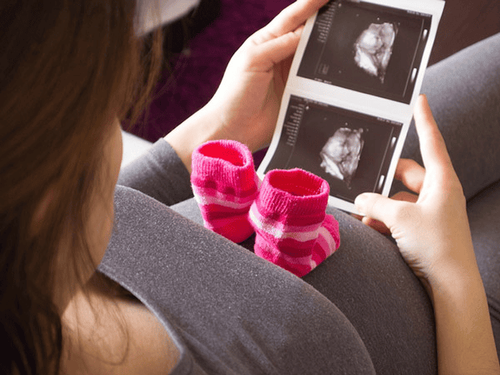This is an automatically translated article.
Posted by Doctor of Laboratory - Vinmec Da Nang International General Hospital.Mother-to-child transmission of group B streptococcus mainly occurs during labor or when membranes rupture prematurely. Currently, with the application of a prophylactic antibiotic regimen based on the results of screening cultures from vaginal discharge in women at 35-37 weeks' gestation, the rate of neonates infected with and mortality from this disease is significantly reduced.
Group B streptococcus (Streptococcus agalactiae or Group B streptococcus (GBS) is a bacterium that is considered the causative agent of neonatal infections with the highest morbidity and mortality in the United States. Between 30-40% and up to 50% in the 1980s, neonatal infections are due to GBS.GBS prevalence is about 1.5 infants/1000 live births of which approximately 10% of infants. Newborns diagnosed with GBS will die.
1. Mechanism and pathogenicity of GBS
Group B Streptococcus belongs to the genus Streptococcus, is a Gram-positive bacteria, commonly found in the gastrointestinal tract and genital tract of women, often causing no symptoms of disease (healthy people carry bacteria).In normal people: GBS can cause urinary tract infections. In pregnant women: In women during labor through genital tract lesions, GBS invades and causes diseases such as GBS, causing postpartum endometritis. In neonates: Due to bacteria capable of synthesizing prostaglandin E2, causing amniotic membrane inflammation and early neonatal infections such as miscarriage, stillbirth, premature rupture of membranes, premature delivery. Infection from the mother during labor due to the fetus inhaling or swallowing amniotic fluid, vaginal fluid, skin lesions in the baby when passing through the birth canal. The disease occurs in the first months of a child's life with common clinical manifestations of sepsis, pneumonia, encephalitis - meningoencephalitis, osteomyelitis... leading to death or severe neurological sequelae. .

Liên cầu khuẩn nhóm B có thể gây viêm màng ối và nhiễm khuẩn sơ sinh sớm
2. Backup strategy
Prophylactic strategies include: Screening for GBS cultures from vaginal swabs or urinalysis in women at 35-37 weeks of gestation to identify at-risk populations and to use antibiotics. prophylaxis in labor with this subject.Some studies have shown great effectiveness from the use of prophylactic antibiotics such as:
21% reduction in the rate of mother's group B strep infection. Reducing the rate of vertical transmission from mother to child leads to a 70% reduction in early neonatal infections.
Trắc nghiệm: Khi thai nhi 32 tuần, mẹ cần chú ý gì?
Khi bước vào tuần thứ 32 của thai kỳ, thai nhi sẽ có bước phát triển vượt trội và dẫn đến những thay đổi về mọi mặt trong cơ thể mẹ. Vậy hãy cùng tìm hiểu xem khi thai 32 tuần chúng ta cần lưu ý những gì qua bài trắc nghiệm sau đây nhé.3. Antibiotic prophylaxis against GBS in labor as recommended by CDC 2010
Indications for antibiotic prophylaxis against GBS:History of giving birth to a child infected with GBS. There is GBS in vaginal or urine specimens during this pregnancy. Screen for GBS in a positive vaginal swab at 35-37 weeks' gestation. GBS infection status unknown during labor and one of the following symptoms: Labor before 37 weeks Water break ≥ 18 hours Temperature ≥ 38°C No indication for prophylactic antibiotics GBS:
Signs of GBS infection in previous pregnancy ( unless vaccination is indicated in this pregnancy). Presence of GBS in vaginal or urine specimens of previous pregnancy (unless vaccination is indicated in this pregnancy). Screening for GBS vaginal fluid is negative, regardless of risk factors in labor. Caesarean section with intact membranes, regardless of GBS infection status or gestational age. Prophylactic antibiotics in labor:
Penicillin is the first choice, ampicillin can be used instead. Women who are mildly allergic to penicillin can substitute with cefazolin. If a strong allergy to penicillin can be substituted with vancomycin or clindamycin.

Penicillin là lựa chọn đầu tay, có thể dùng ampicillin thay thế
4. Results of screening cultures of Group B Streptococcus (GBS) from vaginal swabs in pregnant women with gestational age 35-37
From January 2019 to December 2019, the Microbiology Laboratory of Vinmec Da Nang International General Hospital performed screening cultures of Group B Streptococcus (GBS) from 1172 vaginal swab samples in women. Pregnant women with a gestational age of 35-37 weeks.As a result, there were 193 patient samples isolated from Group B Streptococcus (GBS). accounted for a rate of 16.5%.
An issue is raised here: Should clindamycin be used as a GBS prophylactic antibiotic as recommended by CDC 2010?
According to the statistics of the results of the antibiogram performed in 193 samples above at the Microbiology Laboratory of Vinmec Danang International Hospital, the rate of GBS resistant to clindamycin has reached 70 %. Therefore, the selection of antibiotics according to the results of the antibiogram always plays an essential role in the treatment.
At Vinmec International General Hospital, there is a package maternity service as a solution to help pregnant women feel secure because of the companionship of the medical team throughout the pregnancy. When choosing Maternity Package, pregnant women can:
The pregnancy process is monitored by a team of qualified doctors Regular check-up, early detection of abnormalities Maternity package helps to facilitate the process. Birth program Newborns receive comprehensive care To register for examination and treatment at Vinmec International General Hospital, you can contact Vinmec Health System nationwide, or register online HERE HERE
References:
Lynne S. Garcia, Henry D. Isenberg (2007), “Microbiology procedures handbook, third edition and 2007 update” Pham Thi Thanh Hien (2011), “Infectious diseases during pregnancy , Medical Publishing House. Centers for Disease Control Prevention (2010), “Prevention of Perinatal Group B Streptococcal Disease: Revised guideline from CDC”. Centers for Disease Control Prevention (1996), “Prevention of Perinatal Group B Streptococcal Disease: a public health perspective”. Nguyen Thi Tuyen (2007), Streptococcus, "Medical microbiology", Medicine Publishing House. Neal R. Chamberlain, “The big picture: Medical microbiology” MORE
What is GBS and why are pregnant women tested? What is amniotic fluid index (AFI) and what does it mean? Importance of group B streptococcus (GBS) test in pregnant women













